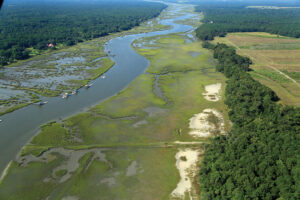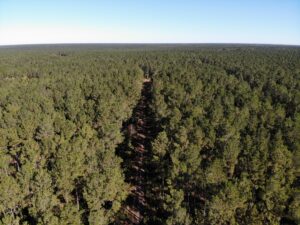A land trust is a nonprofit organization with a mission to protect land forever. This is typically accomplished by helping landowners protect the character and valuable natural resources on their property with conservation easements. In addition to the landowner’s benefit of preserving their land and legacy, there are substantial community benefits including clean water, protected scenic views, and native wildlife habitats. Protecting these conservation values benefits both future generations of landowners and the community as a whole.
Conservation easements are voluntary, legally binding agreements between a landowner and a land trust. With this agreement, the landowner agrees to permanently eliminate some of the uses of their land, while retaining ownership and control. The landowner and land trust work together to determine which uses should be prohibited to protect the conservation values of the land and which uses should be retained for current and future owners. For instance, our easement donors usually decide to retain the right to continue to live on the land, farm and manage timber, enjoy hunting and other pursuits, allow for a limited number of additional future residences for their family members, and sell, lease, or bequeath it to their heirs. In accepting the easement, the land trust is obligated to forever ensure the provisions of the easement are upheld.
Lowcountry Land Trust serves as a partner and resource to South Carolina landowners to create a lasting, positive impact. The largest local land trust in South Carolina, Lowcountry Land Trust, holds more conservation easements and acreage than any organization in the state.
We value landowners’ wishes to continue to use their land as appropriate. The work of Lowcountry Land Trust is in direct harmony with the culture and activity of the region. By protecting our land and ecosystem through conservation easements, we can enjoy the Lowcountry for generations to come.
MEET THE LAND PROTECTION TEAM
With its highly focused mission and many years of experience, backed by dedicated supporters and a substantial stewardship endowment, Lowcountry Land Trust’s Land Protection team is well-equipped to work with landowners in creating conservation easements and safeguarding those easements in perpetuity or in purchasing land when appropriate. Learn more about our land protection team below!
David Ray
David Ray is Lowcountry Land Trust’s Chief Conservation Officer. Previously an attorney in government, large firms, and academic settings, he became Lands Program Director for the Southern Appalachian Highlands Conservancy in 2002. Subsequently, he managed conservation planning and grant-making programs at the Open Space Institute and has led land protection and restoration programs for The Nature Conservancy in the Southern Blue Ridge and Colorado. David holds degrees from Davidson College and the University of Georgia School of Law. During his career, he has played a significant role in over fifty conservation projects on more than 40,000 acres.
Josh Bell
Josh Bell works closely with landowners and our various partners in conservation throughout the Lowcountry to achieve land protection goals. Upon earning his Bachelor of Business Administration from UGA, Josh began his career as a field biologist in Savannah. He became intimate with our coastal region’s geography and ecosystems by working in the field throughout the Lowcountry. Before joining Lowcountry Land Trust, Josh was the Stewardship Director for the Open Land Trust. He gained extensive knowledge of the intricacies of conservation easements and the vital role of dedicated landowners in ensuring that our fragile Lowcountry landscape is protected forever.
Natalie Olson
Natalie Olson joined the Lowcountry Land Trust in 2021 as the Sea Islands Program Director. She is responsible for pursuing strategies to conserve land on the sea islands, with a special focus on Johns and Wadmalaw Islands. Before joining the Lowcountry Land Trust team, Natalie worked for Conservation Voters of South Carolina, the Coastal Conservation League, and private-sector wetland mitigation banking. She holds a Bachelor of Arts in Environmental Science from the University of Florida and a Juris Doctor from the Charleston School of Law.
Sam Seawell
Sam Seawell is a well-known conservationist in the Lowcountry community, having worked with Lowcountry Land Trust for nearly four years serving as a primary point of contact for landowners, stewarding a portfolio of conservation easements, and playing a vital role in the protection of new land. Sam now strengthens the community through conservation in his role as Community Lands Director. Before working with Lowcountry Land Trust, Sam graduated from The University of the South with a Bachelor of Arts in Environment and Sustainability and worked for several conservation and natural resources organizations throughout the country, such as Georgia-Alabama Land Trust, Trout Unlimited, and the Ucross High Plains Stewardship Initiative.
Carl Taylor
Carl Taylor joined the Lowcountry Land Trust team in 2016 and serves as the Geographic Information System (GIS) and Conservation Planning Manager. In this role, Carl creates maps and performs geospatial parcel and ecosystem analyses vital to the completion of conservation easement projects. He also creates landscape-scale conservation plans and tools that support our overall conservation mission in the Lowcountry. He holds a Bachelor of Science from James Madison University and both a Master of Science in Environmental Studies and a Master of Public Administration from the College of Charleston.
Marlo Mytty
Marlo Mytty joined Lowcountry Land Trust in 2023 and is the Conservation Operations Manager supporting the organization’s land protection team. Marlo holds a Bachelor of Science in Forest Resources from the University of Washington, where she studied forest ecology with an emphasis on wildlife and environmental horticulture. Before working for Lowcountry Land Trust, Marlo worked for The Nature Conservancy in WA state, supporting conservation programs, land protection, and stewardship, as well as for Conservation NW, where she coordinated the annual fundraising auction and a remote camera monitoring program that documented wildlife in the Cascades. She also has experience in environmental consulting, wetland, and restoration work.
FREQUENTLY ASKED QUESTIONS
In most cases, the desire to protect the natural and rural character of the land, as well as its natural resources, motivates a landowner to donate a conservation easement. Most Lowcountry landowners have a deep-seated connection with their land and want to protect that natural heritage. Those who have inherited family land from several generations feel obligated to pass it on intact to their children.
A well-designed conservation easement will allow a landowner to prevent unwanted uses but encourage traditional, low-impact activities that can generate income. It can be a valuable tool for estate planning as well, since an easement may reduce the taxes paid by the beneficiary of the estate. Perhaps most of all, an easement will provide a landowner with peace of mind in knowing that people with similar values and objectives will forever keep a vigilant watch over the land they love.
There are several significant tax incentives for donating a conservation easement in South Carolina. Conceptually, an easement reduces the development potential of a property, thereby decreasing its market value. Since resource conservation, even on private land, is in the public interest, the market value of that reduction may be considered as a charitable donation by the IRS and by the SC Department of Revenue. Currently (in 2018), the IRS allows the donor of a qualified conservation easement to take an income tax deduction for as much as the full value of that donation in the year of the gift, limited to 50% of the donor’s adjusted gross income, with any unused portion of the donation carried over for fifteen additional years. This is the general structure for both individuals as well as individual members of pass-through entities like S-Corps, LLCs, and Partnerships. Corporations, however, are further limited to 10% of their taxable income while a qualified farmer or rancher is eligible to deduct 100% of their adjusted gross income.
As an added benefit, the S.C. Department of Revenue allows easement donors to claim an income tax credit for up to 25% of the value of their donation, capped at $250 per acre. No more than $52,500 of the total credit may be used in a single year, but the remainder may be carried forward indefinitely or sold, gifted or bequeathed.
A conservation easement may also significantly reduce land values and therefore reduce the estate taxes that must be paid by the heirs of an estate. This benefit is especially valuable for families that have land as a significant portion of their net worth.
The Lowcountry Land Trust recommends that a landowner review a draft of the conservation easement with appropriate professional advisors.
- An appraiser must determine the market value of the conservation easement, which is required if the landowner intends to claim income tax benefits.
- An attorney should review the draft conservation easement to provide legal advice.
- An accountant can determine the income tax implications of the donation.
- An estate planner can review the implications of the easement for the landowner’s estate.
- In addition, the Land Trust will require a legal description of the property and verification of title from a real estate attorney, and a surveyor may be needed to clearly delineate the property to be protected. Other costs may be incurred based upon your individual situation.
The financial value of a conservation easement depends on the characteristics of the land it protects, the surrounding conditions and the extent of the restrictions placed on the use of the land. Generally, the more restrictive the easement, the higher the easement value. To determine the easement value, the land must be appraised at its fair market value both with and without the easement restrictions. The difference in these appraisal values at the time the easement is put in place becomes the value of the easement. It is this value that may be used for charitable donation purposes. Commissioning an appraisal is the responsibility of the landowner, and it is important to use an appraiser experienced with the specialized nature of conservation easement appraisals.
Most private land having significant ecological, historic, scenic or natural resource value provides a benefit to the public and can therefore be protected by an easement. This includes forests, wetlands, waterways, farmland, endangered species habitat, beaches and other natural or historic areas. In regard to tax benefits, the Internal Revenue Service code and regulations have specific criteria for eligibility for a qualified conservation easement.
Conservation easement projects are evaluated on a case-by-case basis. LLT staff members visit each potential site to assess its specific conservation values. If the property is determined to have significant conservation values, then the Land Trust must be sure that its involvement will bring a meaningful contribution to the protection of those values. The next consideration is the degree to which the rights and uses that the landowner wishes to retain are compatible with the long-term protection of the conservation values. The Land Trust must also evaluate the long-term cost and feasibility of ensuring the terms of the easement are upheld. These decisions are made by LLT’s Board of Trustees based upon the recommendations of the staff.
A conservation easement restricts the economic and development potential of the land, which reduces the fair market value for both current and future owners. Although this can limit the number of potential buyers for the land, experience has shown there is a growing market for conservation lands. While the income and estate tax benefits of an easement can be substantial, the short-term profit derived from selling the land to a developer will almost always outweigh the potential tax savings. Ultimately, a landowner must be absolutely certain that they can live with the restrictions imposed by an easement, as these restrictions are forever binding once the easement has been executed.
No, unless that is the intent of the landowner. Easements donated to the Land Trust do not require public access. Although a conservation easement must provide a public benefit in order to qualify for the income and estate tax incentives, the IRS and S.C. Department of Revenue recognize the significant public benefit provided by the protection of conservation values on private land.
A landowner may specify by will that a conservation easement be placed on his property upon his death. In addition to consulting a tax advisor or estate planner, the landowner should contact the Lowcountry Land Trust as part of his estate planning to negotiate the broad terms of such an easement. If the easement qualifies under federal tax law as a qualified conservation contribution, it can be expected to reduce the value of the land included in the estate and, therefore, any estate tax due.
The time it takes to design and execute a conservation easement depends upon many factors, including the size and complexity of the property and its ownership, but usually will fall into the 3-4 month range. At minimum, this process involves an intensive inspection of the property, the negotiation and design of the easement document, and the legal execution of the conservation easement. In addition, the LLT Conservation Committee and the full Board of Trustees must review and approve all easements prior to acceptance by LLT. A landowner also needs time to contemplate both the easement and a partnership with LLT as well as consult qualified appraisers, attorneys, and other advisors to ensure the easement reflects their long-term interests. An interested landowner should begin talking to LLT staff in the spring to ensure completion of an easement that calendar year. Landowners should not expect to complete an easement by December 31 if they contact LLT after September 15.
LLT funds its operations through contributions of its loyal regular donors and through the support of private foundations. At this time, we do not charge a fee for the time and effort required to design and execute a conservation easement on family lands. We do, however, request that all easement donors make a meaningful contribution to our Stewardship Fund. This fund has been established specifically to support annual monitoring of all protected properties and, when necessary, enforcement of the easement terms. A stewardship contribution may be made in either a single lump sum or spread over a period of several years. Our easement donors are also encouraged to contribute annually to our operations, which helps offset the cost of providing easement design services to prospective easement donors.
THE EBB & FLOW BLOG: CONSERVATION EASEMENTS

Preserving Vital Ecosystems through Corporate Partnerships
Lowcountry Land Trust is thrilled to announce the successful closing of two significant conservation easements on 2,169 acres in Jasper County and 733 acres in Charleston County. Both conservation easements

396-Acre Stevens Family Farm Protected Forever
Nestled at the gateway of Wadmalaw Island lies a pristine piece of land known as Stevens Family Farm – the venue for Lowcountry Land Trust’s 2024 Spring Gathering. This 396-acre

2,851 Acres Protected Forever at Turkey Hill Plantation
Jasper County, SC – Lowcountry Land Trust proudly announces the successful recording of a new conservation easement on 2,851 acres of significant forest land in Jasper County. The permanent protection
View our Official Landowner Guide (Click above Image)
HELP US CONSERVE MORE LAND
By working together with community leaders, private landowners, businesses, and other conservation organizations, we can protect the open land that we need for agriculture, wildlife habitat, resilient infrastructure, and recreational enjoyment.
Lowcountry Land Trust’s primary strategic priority is to protect properties highly significant to rural landscapes, urbanizing communities, and the Lowcountry’s sense of place.







